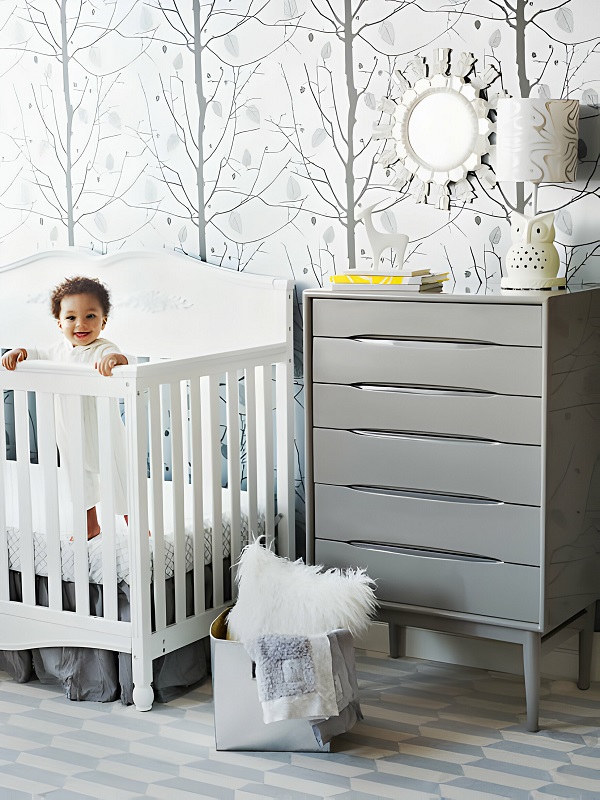Last Updated on January 1, 2025
To transition your baby out of the bassinet, wait until they outgrow it or reach the weight limit, show signs of rolling over, or seem uncomfortable. Start by introducing the crib for naps, ensuring a safe, familiar environment. Gradually move to overnight sleeps, maintaining bedtime routines for smooth adjustment.
The journey of parenting is filled with numerous milestones, one of which is transitioning your baby from a bassinet to a crib. This significant step marks a new phase in your baby’s development and can be both exciting and daunting. The process requires patience, understanding, and a gentle approach to ensure it’s smooth and stress-free for both you and your baby. We provide a detailed guide on how to make this transition as seamless as possible, covering everything from recognizing the right time to making the crib welcoming.

Read More – How To Get Baby To Sleep In Bassinet?
Right Time for Transition Your Baby
The first question that often arises is, “When is the right time to move my baby out of the bassinet?” While there’s no one-size-fits-all answer, there are several indicators to watch for:
- Growth and Development: Most bassinets have a weight limit, which is typically around 15-20 pounds. Additionally, if your baby has started rolling over or pulling up, it’s safer to transition them to a crib.
- Discomfort or Cramped Space: If your baby seems cramped or is frequently waking up due to hitting the bassinet sides, it might be time for more spacious sleeping quarters.
- Curiosity and Awareness: As babies grow, they become more curious about their surroundings. A crib can offer them a better view of their environment, stimulating their developing senses.
Preparing for the Transition
Once you’ve determined it’s the right time to make the move, preparation is key to ensuring a smooth transition.
- Safety First: Ensure the crib meets all current safety standards. The mattress should be firm, and there should be no loose bedding or soft toys that pose a suffocation risk.
- Familiar Environment: Make the crib feel familiar by using the same bedding (if size allows) or placing a well-loved toy in the crib. This can help your baby feel more secure in the new sleeping environment.
- Gradual Introduction: Start by introducing your baby to the crib during daytime naps. This helps them become accustomed to the new space without the pressure of spending a whole night there.
Making the Transition
With everything in place, you’re ready to start the transition. Here are some steps to follow:
- Maintain Routine: Keep your bedtime routine consistent. Bath, story, and lullabies in the same order can reassure your baby that not everything is changing.
- Start with Naps: As mentioned, begin with daytime naps in the crib to build familiarity.
- Overnight Stays: Once your baby seems comfortable napping in the crib, you can start putting them down there at night. Expect some resistance initially; it’s normal for babies to take time to adjust.
- Stay Close: For the first few nights, you might want to sleep closer to the crib to reassure your baby with your presence. A baby monitor can also help keep an eye on them without disturbing their sleep.
- Be Patient and Flexible: Some babies take on the transition easily, while others need more time. Be prepared to have some difficult nights and remember that it’s okay to take a step back if needed.
Read More – How to Design Your Bedroom for Better Sleep?
Troubleshooting Common Challenges
Despite your best efforts, you may encounter some challenges. Here are a few tips for common issues:
- Resistance to Change: If your baby is particularly resistant, slow down the transition. Spend more time on daytime naps before moving to overnight stays.
- Waking Up More Frequently: This is normal in the beginning. Maintain a calm demeanor during nighttime awakenings. Soothe your baby without taking them out of the crib if possible.
- Regression: Sometimes, babies who’ve adjusted well might suddenly start resisting the crib due to developmental leaps or teething. Stay consistent with your routine, but be more flexible and comforting.
The Emotional Aspect
It’s important to recognize that this transition is not only a physical but also an emotional process for both you and your baby. For parents, seeing their baby move to a crib can be a bittersweet reminder of how quickly they are growing. For babies, the change in their sleeping environment can be unsettling at first. Being patient, providing comfort, and gradually introducing the change can help manage these emotions.

Read More – Does Baby Oil Expire?
FAQs
How did the baby move out of the bassinet?
Transition your baby from the bassinet by introducing them to the crib during naps, making the crib environment familiar and comfortable, and gradually moving to overnight sleeps while maintaining their usual bedtime routine to ensure a smooth adjustment.
What age do babies move out of the bassinet?
Babies typically move out of the bassinet between 4 to 6 months old. This range can vary depending on the baby’s growth, mobility (such as rolling over or sitting up), and the bassinet’s weight limit.
When is a baby too big for a bassinet?
A baby is too big for a bassinet typically around 4 to 6 months when they reach the bassinet’s weight limit, start to roll over, pull themselves up, or seem cramped. It’s time to transition to a crib for safety and comfort as they grow and become more active.
How do I get my baby out of the bassinet?
Start with short naps in the crib to build familiarity, ensure the crib feels safe and cozy by using familiar bedding or toys, and maintain a consistent bedtime routine. Patience and gradual transition are key to moving your baby out of the bassinet.
When should I wean my baby from a bassinet?
Wean your baby from the bassinet when it shows signs of outgrowing it, such as reaching the weight limit, beginning to roll over, or seeming cramped. This usually happens around 4 to 6 months of age.
How long does it take for a baby to grow out of a bassinet?
The time it takes for a baby to grow out of a bassinet varies but generally occurs by 4 to 6 months. Factors include the baby’s size, mobility development, and the specific bassinet’s weight capacity and design.
Conclusion
Moving your baby out of the bassinet is a significant milestone that requires careful planning and patience. By recognizing the right time, preparing both the crib and your baby, and proceeding with the transition with patience and love, you can ensure a smooth adjustment for your little one. Remember, every baby is unique, and what works for one may not work for another. The key is to remain flexible, attentive to your baby’s cues, and supportive throughout the process.

